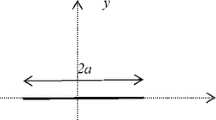Abstract
A discrete dislocation analysis of the continuous plastic crack is carried out for ordered alloys. The crack is assumed to nucleate and reach a size where it will emit a set of lattice dislocations in order to decrease its energy. Further growth of the crack takes place elastically until it can emit the next set of lattice dislocations. Repeated emission of lattice dislocations, with elastic crack growth in between, leads to the Griffith configuration where the energy variation with size of the crack is zero. It is shown that a crack, either tensile or shear, can be stabilized by the presence of antiphase boundary energy alone. In the absence of frictional stress or with the very low frictional stresses encountered in real materials, the lattice dislocations are generated in pairs on each slip plane. However, when the frictional stress is high, the lattice dislocations are generated as single ones, giving rise to an antiphase boundary between the crack and the lattice dislocation.
Similar content being viewed by others
References
K. Jagannadham and M. J. Marcinkowski, submitted for publication.
M. J. Marcinkowski and E. S. P. Das, Int. J. Fracture. 10 (1974) 181.
M. J. Marcinkowski and R. W. Armstrong, J. Appl. Phys. 43 (1972) 2548.
K. Sadananda, K. Jagannadham and M. J. Marcinkowski, Phys. Stat. Solid. 44 (1977) 633.
M. J. Marcinkowski, J. Appl. Phys. 46 (1975) 496.
M. J. Marcinkowski and E. S. P. Das, Phys. Stat. Solid. A8 (1971) 249.
K. Jagannadham and M. J. Marcinkowski, ibid. (to be published)
M. J. Marcinkowski, “Order-Disorder Transformations in Alloys,” edited by H. Warllmont, (Springer-Verlag, New York, 1974) p. 364.
Sheng-Ti Fong, M. J. Marcinkowski and K. Sadananda, Acta Met. 21 (1973) 799.
N. S. Stoloff and I. L. Dillamore, “Ordered Alloys — Structural Applications and Physical Metallurgy,” edited by B. H. Kear, C. T. Sims, N. S. Stoloff and J. H. Westbrook, (Clastros, Baton Rouge, 1970).
J. P. Hirth and J. Lothe, “Theory of Dislocations” (McGraw-Hill, New York, 1968).
M. J. Marcinkowski, “Advances in Materials Research,” edited by H. Herman (Wiley, New York, 1975) 5382.
Author information
Authors and Affiliations
Rights and permissions
About this article
Cite this article
Jagannadham, K., Marcinkowski, M.J. Continuous plastic cracks in ordered alloys. J Mater Sci 13, 1725–1739 (1978). https://doi.org/10.1007/BF00548736
Received:
Accepted:
Issue Date:
DOI: https://doi.org/10.1007/BF00548736




